Someone recently asked me a question about why a church in San
Jose is celebrating Easter this Sunday (May 5th).
”
Wasn’t Easter several weeks ago?
”
he wondered.
Someone recently asked me a question about why a church in San Jose is celebrating Easter this Sunday (May 5th). “Wasn’t Easter several weeks ago?” he wondered. It turned out that he was referring to an Eastern Orthodox church, one of the family of self-governing churches which are held together by shared history, tradition, doctrine and sacraments.
On the first Pentecost Jesus’ disciples were empowered by the Holy Spirit to spread the Gospel throughout the world. When the capital of the Roman Empire was moved to Constantinople (now Istanbul, Turkey) in the third century, that city became a rival with Rome for political and religious power. Missionaries from Constantinople were responsible for spreading Christianity throughout Eastern Europe.
A gradual process of estrangement between the Eastern and Western branches of the Christian Church resulted in a final break in relations between them: the Great Schism of 1054. One of their points of disagreement was the increasing claims of special authority by the Bishop of Rome, the Pope.
The Orthodox follow an ancient calendar known as “Julian,” which explains why their religious holidays fall on different dates than in the Western churches (which follow the more recent Gregorian calendar). They have many areas of similarity with other Christians, though: they recognize seven sacraments (called Holy Mysteries): baptism, chrismation (similar to confirmation but administered immediately after baptism), Holy Eucharist (communion), penance (confession), marriage, Holy Unction (anointing for healing) and ordination.
Other characteristics of Orthodoxy are a reverence for the Bible (which includes some additional books sometimes called the Apocrypha), veneration of icons (sacred stylized artwork representing Jesus, Mary, or saints), and a belief in the Nicene Creed (a traditional summary of faith dating from the fourth century, but with slightly different wording than used in the Western churches).
Married men may be ordained priests, but may not marry after ordination; only those practicing celibacy are permitted to become bishops. Women cannot be ordained, though there are many Orthodox nuns.
The Divine Liturgy, the Orthodox service of Holy Communion, is celebrated with elaborate ceremony, including use of incense, singing of ancient prayers, and reception of both bread and wine by the congregation.
There are over 2000 Eastern Orthodox congregations in the United States with a total membership of approximately four million. Since South County does not have any Orthodox churches yet, local residents belong to a number of parishes representing many ethnic groups in San Jose and elsewhere in the Bay Area.
One of these parishes was in the news recently. In the late 1950s an the congregation of an Episcopal Church in Palo Alto broke with their bishop over doctrine. Their pastor had himself reordained as a priest in the Antiochian Orthodox Church, and they established a small church in Los Altos Hills. As the Mideastern population of Santa Clara County increased, the parish grew and prospered. It was this church, the Orthodox Church of the Redeemer, which was the victim of a tragic, well-publicized arson attack last month.














